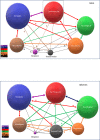Multimorbidity gender patterns in hospitalized elderly patients
- PMID: 31990911
- PMCID: PMC6986758
- DOI: 10.1371/journal.pone.0227252
Multimorbidity gender patterns in hospitalized elderly patients
Abstract
Patients with multimorbidity and complex health care needs are usually vulnerable elders with several concomitant advanced chronic diseases. Our research aim was to evaluate differences in patterns of multimorbidity by gender in this population and their possible prognostic implications, measured as in-hospital mortality, 1-month readmissions, and 1-year mortality. We focused on a cohort of elderly patients with well-established multimorbidity criteria admitted to a specific unit for chronic complex-care patients. Multimorbidity criteria, the Charlson, PROFUND and Barthel indexes, and the Pfeiffer test were collected prospectively during their stays. A total of 843 patients (49.2% men) were included, with a median age of 84 [interquartile range (IQR) 79-89] years. The women were older, with greater functional dependence [Barthel index: 40 (IQR:10-65) vs. 60 (IQR: 25-90)], showed more cognitive deterioration [Pfeiffer test: 5 (IQR:1-9) vs. 1 (0-6)], and had worse scores on the PROFUND index [15 (IQR:9-18) vs. 11.5 (IQR: 6-15)], all p <0.0001, while men had greater comorbidity measured with the Charlson index [5 (IQR: 3-7) vs. 4 (IQR: 3-6); p = 0.002]. In the multimorbidity criteria scale, heart failure, autoimmune diseases, dementia, and osteoarticular diseases were more frequent in women, while ischemic heart disease, chronic respiratory diseases, and neoplasms predominated in men. In the analysis of grouped patterns, neurological and osteoarticular diseases were more frequent in females, while respiratory and cancer predominated in males. We did not find gender differences for in-hospital mortality, 1-month readmissions, or 1-year mortality. In the multivariate analysis age, the Charlson, Barthel and PROFUND indexes, along with previous admissions, were independent predictors of 1-year mortality, while gender was non-significant. The Charlson and PROFUND indexes predicted mortality during follow-up more accurately in men than in women (AUC 0.70 vs. 0.57 and 0.74 vs. 0.62, respectively), with both p<0.001. In conclusion, our study shows differing patterns of multimorbidity by gender, with greater functional impairment in women and more comorbidity in men, although without differences in the prognosis. Moreover, some of these prognostic indicators had differing accuracy for the genders in predicting mortality.
Conflict of interest statement
The authors have declared that no competing interests exist.
Figures





References
-
- GBD 2017 DALYs and HALE Collaborators. Global, regional, and national disability-adjusted life-years (DALYs) for 359 diseases and injuries and healthy life expectancy (HALE) for 195 countries and territories, 1990–2017: a systematic analysis for the Global Burden of Disease Study 2017. Lancet. 2018;392(10159):1859–1922. 10.1016/S0140-6736(18)32335-3 . - DOI - PMC - PubMed
-
- Clerencia-Sierra M, Calderón-Larrañaga A, Martínez-Velilla N, Vergara-Mitxeltorena I, Aldaz-Herce P, Poblador-Plou B, et al. Multimorbidity patterns in hospitalized older patients: associations among chronic diseases and geriatric syndromes. PLoS One. 2015;10(7):e0132909 10.1371/journal.pone.0132909 0132909. - DOI - PMC - PubMed

